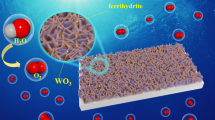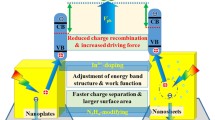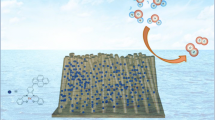Abstract
Tungsten trioxide (WO3) has been conceived as a promising photoanode material for photoelectrochemical (PEC) water oxidation. Therefore, many efforts have been made to improve its PEC performances. Herein, a novel heterojunction is fabricated through combining rocksalt CoO (R-CoO) or blende CoO (B-CoO) nanosheets with WO3 nanoplates using a spin-coating method. The typical type II heterojunctions, e.g., WO3/R-CoO and WO3/B-CoO, both have exhibited higher photocurrent densities than pristine WO3 photoanode. The photocurrent densities of WO3/R-CoO, WO3/B-CoO and WO3 are 0.53 mA cm−2, 0.45 mA cm−2 and 0.31 mA cm−2 at 1.23 V vs. reversible hydrogen electrode, respectively. For the WO3/R-CoO photoanode, the surface charge separation efficiency is 50.95% and the photoconversion efficiency is 0.062%, which are both higher than the WO3 and WO3/B-CoO photoanodes. The enhanced PEC performances are due to the type II heterojunction between WO3 and R-CoO (or B-CoO), which facilitates the absorption of visible light and charge transport. The better performance of WO3/R-CoO than that of WO3/B-CoO may be due to the deeper valence band position of R-CoO. Our work demonstrates that R-CoO (or B-CoO) can couple with WO3 to form a type II heterojunction to improve the PEC water oxidation performance.









Similar content being viewed by others
References
Liu C, Luo H, Xu Y, Wang W, Liang Q, Mitsuzaki N, Chen Z (2019) Cobalt–phosphate-modified Mo: BiVO4 mesoporous photoelectrodes for enhanced photoelectrochemical water splitting. J Mater Sci 54:10670–10683. https://doi.org/10.1007/s10853-019-03658-7
Yan D, Liu J, Fu X, Liu P, Luo H (2019) Low-temperature synthesis of mesoporous boron carbides as metal-free photocatalysts for enhanced CO2 reduction and generation of hydroxyl radicals. J Mater Sci 54:6151–6163. https://doi.org/10.1007/s10853-018-03284-9
Kudo A, Miseki Y (2009) Heterogeneous photocatalyst materials for water splitting. Chem Soc Rev 38:253–278
Wang Q, Domen K (2019) Particulate photocatalysts for light-driven water splitting: mechanisms, challenges, and design strategies. Chem Rev 120:919–985
Fujishima A, Honda K (1972) Electrochemical photolysis of water at a semiconductor electrode. Nature 238:37–38
Yan D, Fu X, Shang Z, Liu J, Luo H (2019) A BiVO4 film photoanode with re-annealing treatment and 2D thin Ti3C2TX flakes decoration for enhanced photoelectrochemical water oxidation. Chem Eng J 361:853–861
Lee DK, Choi KS (2018) Enhancing long-term photostability of BiVO4 photoanodes for solar water splitting by tuning electrolyte composition. Nat Energy 3:53–60
Chang H, Shang Z, Kong Q, Liu P, Liu J, Luo H (2019) α-Fe2O3 nanorods embedded with two-dimensional 0 0 1 facets exposed TiO2 flakes derived from Ti3C2TX MXene for enhanced photoelectrochemical water oxidation. Chem Eng J 370:314–321
Yan D, Liu J, Shang Z, Luo H (2017) Ti-doped α-Fe2O3 nanorods with controllable morphology by carbon layer coating for enhanced photoelectrochemical water oxidation. Dalton Trans 46:10558–10563
Han J, Liu Z, Guo K, Wang B, Zhang X, Hong T (2015) High-efficiency photoelectrochemical electrodes based on ZnIn2S4 sensitized ZnO nanotube arrays. Appl Catal B Environ 163:179–188
Zhang B, Wang Z, Huang B et al (2017) Anisotropic photoelectrochemical (PEC) performances of ZnO single-crystalline photoanode: effect of internal electrostatic fields on the separation of photogenerated charge carriers during PEC water splitting. Chem Mater 28:6613–6620
Liu G, Shi J, Zhang F et al (2014) A tantalum nitride photoanode modified with a hole-storage layer for highly stable solar water splitting. Angew Chem Int Ed 53:7295–7299
Liu G, Ye S, Yan P et al (2016) Enabling an integrated tantalum nitride photoanode to approach the theoretical photocurrent limit for solar water splitting. Energy Environ Sci 9:1327–1334
Kalanur SS, Yoo IH, Eom K, Seo H (2018) Enhancement of photoelectrochemical water splitting response of WO3 by Means of Bi doping. J Catal 357:127–137
Zhang J, Chang X, Li C, Li A, Liu S, Wang T, Gong J (2018) WO3 photoanodes with controllable bulk and surface oxygen vacancies for photoelectrochemical water oxidation. J Mater Chem A 6:3350–3354
Ma M, Zhang K, Li P, Jung M, Jeong M, Park J (2016) Dual oxygen and tungsten vacancies on a WO3 photoanode for enhanced water oxidation. Angew Chem Int Ed 128:11998–12002
Wang Y, Tian W, Chen C, Xu W, Li L (2019) Tungsten trioxide nanostructures for photoelectrochemical water splitting: material engineering and charge carrier dynamic manipulation. Adv Funct Mater 29:1809036
Xu F, Yao Y, Bai D et al (2015) A significant cathodic shift in the onset potential and enhanced photoelectrochemical water splitting using Au nanoparticles decorated WO3 nanorod array. J Colloid Interf Sci 458:194–199
Zheng G, Wang J, Liu H et al (2019) Tungsten oxide nanostructures and nanocomposites for photoelectrochemical water splitting. Nanoscale 11:18968–18994
Wang Y, Gao C, Ge S, Yu J, Yan M (2016) Platelike WO3 sensitized with CdS quantum dots heterostructures for photoelectrochemical dynamic sensing of H2O2 based on enzymatic etching. Biosens Bioelectron 85:205–211
Kwong WL, Savvides N, Sorrell CC (2012) Electrodeposited nanostructured WO3 thin films for photoelectrochemical applications. Electrochim Acta 75:371–380
Liu Z, Wu J, Zhang J (2016) Quantum dots and plasmonic Ag decorated WO3 nanorod photoanodes with enhanced photoelectrochemical performances. Int J Hydrog Energy 41:20529–20535
Zhang T, Zhu Z, Chen H et al (2015) Iron-doping-enhanced photoelectrochemical water splitting performance of nanostructured WO3: a combined experimental and theoretical study. Nanoscale 7:2933–2940
Xiao YH, Xu CQ, Zhang WD (2017) Facile synthesis of Ni-doped WO3 nanoplate arrays for effective photoelectrochemical water splitting. J Solid State Electrochem 21:3355–3364
Bai S, Yang X, Liu C, Xiang X, Luo R, He J, Chen A (2018) An integrating photoanode of WO3/Fe2O3 heterojunction decorated with NiFe-LDH to improve PEC water splitting efficiency. ACS Sustain Chem Eng 6:12906–12913
Su J, Guo L, Bao N, Girmes C (2011) Nanostructured WO3/BiVO4 heterojunction films for efficient photoelectrochemical water splitting. Nano Lett 11:1928–1933
Hou Y, Zuo F, Dagg AP, Liu J, Feng P (2014) Branched WO3 nanosheet array with layered C3N4 heterojunctions and CoOx nanoparticles as a flexible photoanode for efficient photoelectrochemical water oxidation. Adv Mater 26:5043–5049
Zhan F, Liu W, Li W, Liu J, Yang Y, Li Y, Chen Q (2016) Efficient solar water oxidation by WO3 plate arrays film decorated with CoOx electrocatalyst. Int J Hydrog Energy 41:11925–11932
Fu J, Xu Q, Low J, Jiang C, Yu J (2019) Ultrathin 2D/2D WO3/g-C3N4 step-scheme H2-production photocatalyst. Appl Catal B Environ 243:556–565
Chen J, Xiao X, Wang Y, Ye Z (2019) Ag nanoparticles decorated WO3/g-C3N4 2D/2D heterostructure with enhanced photocatalytic activity for organic pollutants degradation. Appl Surf Sci 467:1000–1010
Rao PM, Cai L, Liu C et al (2014) Simultaneously efficient light absorption and charge separation in WO3/BiVO4 core/shell nanowire photoanode for photoelectrochemical water oxidation. Nano Lett 14:1099–1105
Grigioni I, Stamplecoskie KG, Selli E, Kamat P (2015) Dynamics of photogenerated charge carriers in WO3/BiVO4 heterojunction photoanodes. J Phys Chem C 119:20792–20800
Wang Y, Tian W, Chen L, Cao F, Guo J, Li L (2017) Three-dimensional WO3 nanoplate/Bi2S3 nanorod heterojunction as a highly efficient photoanode for improved photoelectrochemical water splitting. ACS Appl Mater Interfaces 9:40235–40243
Xu J, Li X, Ju Z et al (2019) Visible-light-driven overall water splitting boosted by tetrahedrally coordinated blende cobalt (II) oxide atomic layers. Angew Chem Int Ed 131:3064–3068
Zou X, Dong Y, Ke J, Ge H, Chen D, Sun H, Cui Y (2020) Cobalt monoxide/tungsten trioxide p-n heterojunction boosting charge separation for efficient visible-light-driven gaseous toluene degradation. Chem Eng J. https://doi.org/10.1016/j.cej.2020.125919
Gui Y, Blackwood DJ (2015) Honey-comb structured WO3/TiO2 thin films with improved electrochromic properties. J Electronchem Soc 162:E205–E212
Tan Z, Li L, Cui C et al (2012) Solution-processed tungsten oxide as an effective anode buffer layer for high-performance polymer solar cells. J Phys Chem C 116:18626–18632
Muhmood T, Khan MA, Xia M, Lei W, Wang F (2017) Enhanced photo-electrochemical, photo-degradation and charge separation ability of graphitic carbon nitride (g-C3N4) by self-type metal free heterojunction formation for antibiotic degradation. J Photochem Photobiol A 348:118–124
Zheng J, Pawar A, Kim C, Kim Y, Kang Y (2018) Highly enhancing photoelectrochemical performance of facilely-fabricated Bi-induced (002)-oriented WO3 film with intermittent short-time negative polarization. Appl Catal B Environ 233:88–98
Zhu Z, Yan Y, Li J (2015) Preparation of flower-like BiOBr–WO3–Bi2WO6 ternary hybrid with enhanced visible-light photocatalytic activity. J Alloy Compd 651:184–192
Zheng G, Wang J, Li H, Li Y, Hu P (2020) WO3/Cu2O heterojunction for the efficient photoelectrochemical property without external bias. Appl Catal B Environ. https://doi.org/10.1016/j.apcatb.2019.118561
Liu Q, Lu H, Shi Z, Wu F, Guo J, Deng K, Li L (2014) 2D ZnIn2S4 nanosheet/1D TiO2 nanorod heterostructure arrays for improved photoelectrochemical water splitting. ACS Appl Mater Interfaces 6:17200–17207
Lee BR, Lee MG, Park H et al (2019) All-solution-processed WO3/BiVO4 core-shell nanorod arrays for highly stable photoanodes. ACS Appl Mater Interfaces 11:20004–20012
Li Y, Liu Z, Ruan M, Guo Z, Li X (2019) 1D WO3 nanorods/2D WO3−x nanoflakes homojunction structure for enhanced charge separation and transfer towards efficient photoelectrochemical performance. Chemsuschem 12:5282–5290
Wu Q, Bu Q, Li S, Lin Y, Zou X, Wang D, Xie T (2019) Enhanced interface charge transfer via nn WO3/Ti–Fe2O3 heterojunction formation for water splitting. J Alloy Compd 803:1105–1111
Corby S, Francàs L, Selim S et al (2018) Water oxidation and electron extraction kinetics in nanostructured tungsten trioxide photoanodes. J Am Chem Soc 140:16168–16177
Low J, Yu J, Jaroniec M, Wageh S, Al-Ghamdi A (2017) Heterojunction photocatalysts. Adv Mater. https://doi.org/10.1002/adma.201601694
Sharma MD, Mahala C, Basu M (2019) Band gap tuning to improve the photoanodic activity of ZnInxSy for photoelectrochemical water oxidation. Catal Sci Technol 9:6769–6781
Acknowledgements
This work was financially supported by the Scientific Research Fund of Hunan Provincial Education Department (18B065) and the Natural Science Foundation of Hunan Province (2019JJ50595).
Author information
Authors and Affiliations
Corresponding authors
Ethics declarations
Conflict of interest
The authors declare that they have no conflict of interest.
Additional information
Handling Editor: Joshua Tong.
Publisher's Note
Springer Nature remains neutral with regard to jurisdictional claims in published maps and institutional affiliations.
Supplementary Information
Below is the link to the electronic supplementary material.
Rights and permissions
About this article
Cite this article
Liu, J., Yang, Q., Liu, J. et al. Enhanced photoelectrochemical water oxidation of WO3/R-CoO and WO3/B-CoO photoanodes with a type II heterojunction. J Mater Sci 56, 8079–8090 (2021). https://doi.org/10.1007/s10853-020-05754-5
Received:
Accepted:
Published:
Issue Date:
DOI: https://doi.org/10.1007/s10853-020-05754-5




